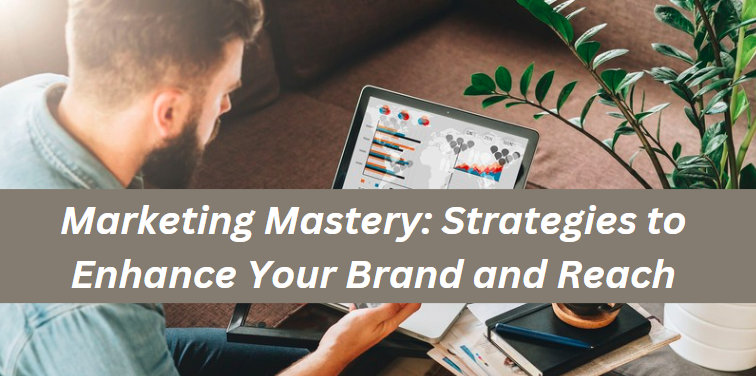Marketing Mastery: Strategies to Enhance Your Brand and Reach
In today’s competitive business environment, mastering marketing is essential for enhancing your brand and reaching your target audience effectively. Successful marketing requires a strategic approach, leveraging various techniques and tools to build brand awareness, engage customers, and drive growth. This guide provides comprehensive strategies to help you achieve marketing mastery and elevate your brand.
Contents [hide]
1. Understanding Your Brand
Define Your Brand Identity
A strong brand identity is the foundation of successful marketing. It includes your brand’s personality, values, and mission.
- Brand Mission and Vision: Clearly articulate your brand’s purpose and long-term goals.
- Brand Personality: Define the human characteristics that best represent your brand (e.g., friendly, innovative, reliable).
- Brand Values: Identify the core principles that guide your brand’s actions and decisions.
Develop a Unique Selling Proposition (USP)
Your USP differentiates your brand from competitors and highlights the unique benefits you offer.
- Identify Your Strengths: Determine what sets your product or service apart.
- Customer Benefits: Focus on how your strengths translate into benefits for your customers.
- Clear and Concise Messaging: Craft a compelling statement that communicates your USP effectively.
2. Building a Robust Digital Presence
Website Optimization
Your website is often the first point of contact for potential customers. Ensure it is optimized for performance and user experience.
- Responsive Design: Ensure your website works seamlessly across all devices.
- SEO Optimization: Implement SEO best practices to improve your search engine rankings.
- User Experience: Make your website easy to navigate, with clear calls to action (CTAs) and a smooth user journey.
Content Marketing
Content marketing involves creating and distributing valuable, relevant content to attract and engage your target audience.
- Blogging: Regularly publish informative and engaging blog posts.
- Video Content: Create videos that explain, entertain, or inspire your audience.
- E-books and Whitepapers: Offer in-depth resources that provide significant value to your customers.
- Webinars and Podcasts: Host online events and podcasts to share knowledge and interact with your audience.
Social Media Marketing
Social media platforms are powerful tools for building brand awareness and engaging with customers.
- Platform Selection: Choose platforms that align with your target audience’s preferences (e.g., Instagram for visual content, LinkedIn for professional networking).
- Content Strategy: Develop a content calendar that includes a mix of promotional, educational, and entertaining posts.
- Engagement: Actively engage with your audience by responding to comments, messages, and mentions.
Email Marketing
Email marketing remains one of the most effective ways to nurture leads and maintain customer relationships.
- Email List Building: Collect email addresses through sign-up forms, landing pages, and lead magnets.
- Personalization: Tailor your emails to the recipient’s preferences and behaviors.
- Automated Campaigns: Use automated email sequences to guide subscribers through the buyer’s journey.
3. Leveraging Data and Analytics
Analytics Tools
Utilize analytics tools to measure the effectiveness of your marketing efforts and make data-driven decisions.
- Google Analytics: Track website traffic, user behavior, and conversion rates.
- Social Media Analytics: Monitor engagement metrics, audience demographics, and content performance on social platforms.
- Email Marketing Analytics: Analyze open rates, click-through rates, and conversion rates of your email campaigns.
Key Performance Indicators (KPIs)
Identify and track key performance indicators that align with your marketing goals.
- Brand Awareness: Monitor metrics like website traffic, social media reach, and brand mentions.
- Engagement: Measure likes, shares, comments, and time spent on your content.
- Conversions: Track sales, lead generation, and other desired actions taken by your audience.
A/B Testing
Conduct A/B tests to compare different versions of your marketing materials and identify what works best.
- Landing Pages: Test different headlines, images, and CTAs to improve conversion rates.
- Email Campaigns: Experiment with subject lines, send times, and email content to boost engagement.
- Ads: Compare ad creatives, copy, and targeting to optimize your advertising spend.
4. Utilizing Paid Advertising
Pay-Per-Click (PPC) Advertising
PPC advertising allows you to place ads on search engines and pay only when someone clicks on your ad.
- Google Ads: Create search ads, display ads, and video ads to reach potential customers.
- Keyword Research: Identify high-performing keywords relevant to your business.
- Ad Copy: Write compelling ad copy that attracts clicks and conversions.
Social Media Advertising
Social media platforms offer targeted advertising options to reach your ideal audience.
- Facebook and Instagram Ads: Use detailed targeting options to reach specific demographics, interests, and behaviors.
- LinkedIn Ads: Target professionals based on job title, industry, and company size.
- Twitter Ads: Promote tweets to reach a broader audience and drive engagement.
Retargeting Campaigns
Retargeting campaigns allow you to re-engage users who have previously interacted with your brand.
- Website Retargeting: Show ads to visitors who have visited your website but did not convert.
- Email Retargeting: Target users who opened your emails but did not take the desired action.
- Social Media Retargeting: Re-engage users who have interacted with your social media profiles or posts.
5. Building Relationships and Community
Influencer Marketing
Collaborate with influencers to leverage their audience and enhance your brand’s credibility.
- Identify Relevant Influencers: Choose influencers whose audience aligns with your target market.
- Authentic Partnerships: Build genuine relationships and create authentic content.
- Campaign Goals: Set clear objectives and measure the impact of your influencer collaborations.
Customer Engagement
Engage with your customers to build loyalty and encourage word-of-mouth marketing.
- Customer Feedback: Collect and act on feedback to improve your products and services.
- Loyalty Programs: Reward loyal customers with exclusive offers, discounts, and perks.
- Community Building: Create online communities (e.g., Facebook groups, forums) where customers can connect and share experiences.
Public Relations
Maintain a positive public image and build relationships with the media.
- Press Releases: Share newsworthy updates and achievements with the media.
- Media Outreach: Develop relationships with journalists and bloggers in your industry.
- Crisis Management: Have a plan in place to address any negative publicity or crises.
6. Embracing Innovation and Trends
Stay Updated with Trends
Keep up with the latest marketing trends and technologies to stay ahead of the competition.
- Industry News: Follow industry blogs, podcasts, and newsletters.
- Conferences and Webinars: Attend events to learn from experts and network with peers.
- Continuous Learning: Invest in ongoing education and training for your marketing team.
Experiment with New Technologies
Adopt new technologies to enhance your marketing efforts and improve efficiency.
- Artificial Intelligence (AI): Use AI for personalized marketing, chatbots, and predictive analytics.
- Augmented Reality (AR): Implement AR experiences to engage customers in innovative ways.
- Marketing Automation: Streamline repetitive tasks and improve campaign efficiency with automation tools.
Sustainable Marketing
Embrace sustainable marketing practices to appeal to eco-conscious consumers.
- Eco-Friendly Products: Promote products that are environmentally friendly.
- Sustainable Practices: Highlight your company’s commitment to sustainability in your marketing campaigns.
- Transparency: Be open and honest about your sustainability efforts and achievements.
Conclusion
Mastering marketing requires a strategic and multifaceted approach. By understanding your brand, building a robust digital presence, leveraging data, utilizing paid advertising, building relationships, and embracing innovation, you can enhance your brand and reach your target audience effectively.
Stay committed to continuous improvement, adapt to changing trends, and always keep your customers at the heart of your marketing efforts. With these strategies, you can achieve marketing mastery and drive your business to new heights.






















































Post Comment